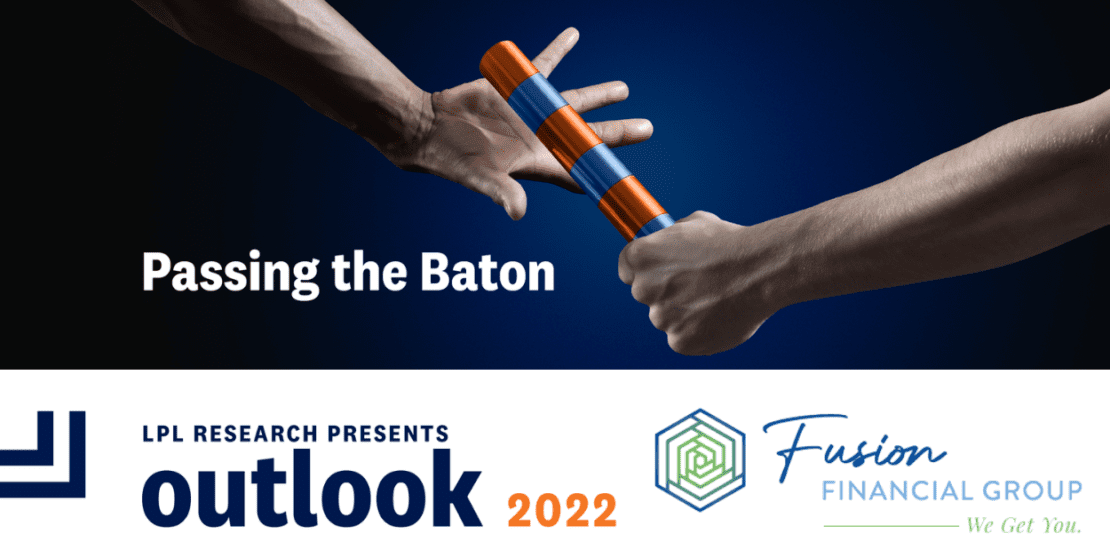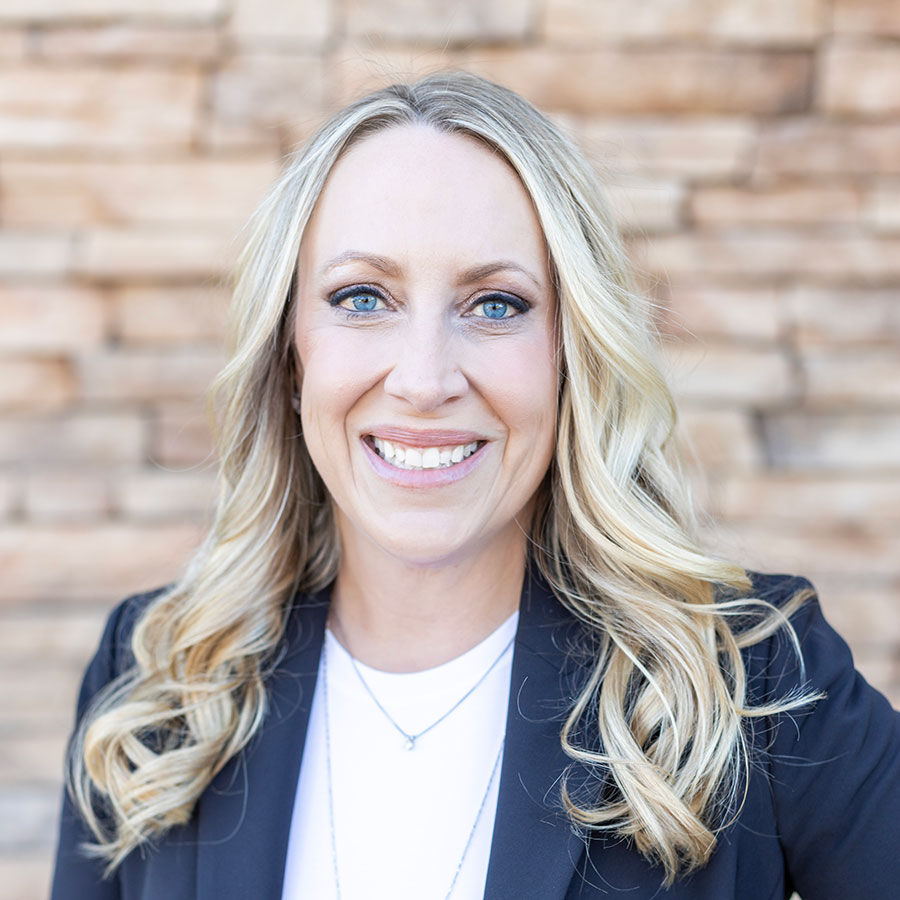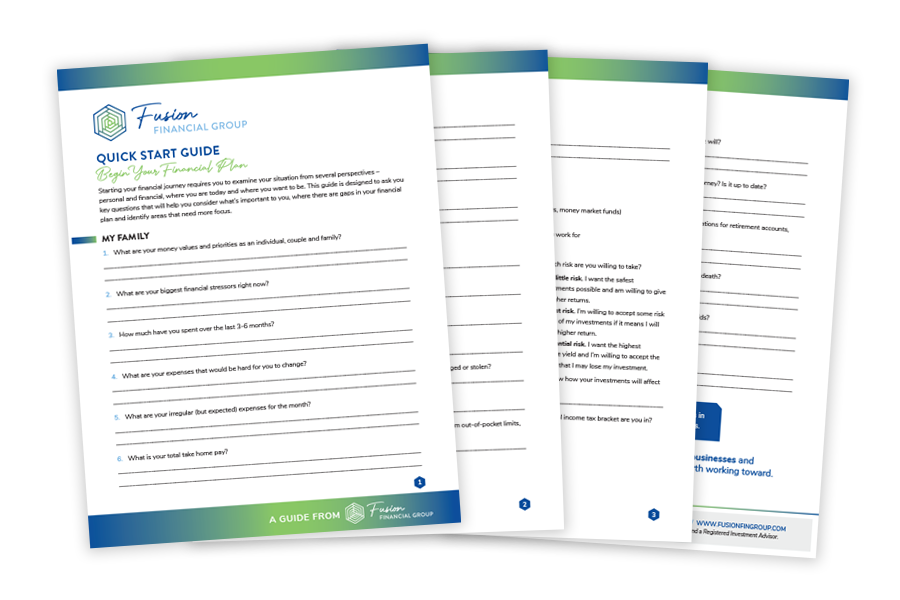2022 Outlook: Passing the Baton
- December 8, 2021
- Posted by: Keri Pugh
- Categories: Investment, Markets

Our resurgent economy grew at over a 6% pace in the first half of the year and is on track for over 5% growth for the year when 2021 draws to a close. The current economic recovery, which started in May 2020, has benefited from widespread vaccine availability and additional fiscal stimulus. While the economy continues to move forward, we’re still feeling the aftershocks of the COVID-19 Delta variant, whether through elevated inflation, supply chain bottlenecks, or an imbalanced labor market. But 2021 also saw positives beyond economic growth, with schools opening their doors and extended family gathering around many Thanksgiving tables, activities that were far less common in 2020. At the same time, the S&P 500 Index continued to advance as corporate America faced this generational challenge with resiliency and saw earnings growth that surprised even the most optimistic pundits.
The recovery has been a testament to our ability to manipulate our world. Scientists developed several vaccines extraordinarily quickly. Central banks and policymakers found ways to insert themselves into the complex network of economic relationships to help bridge the worst of the economic crisis. But the same scale that multiplies our control of the world can also multiply potential mistakes and make robust, complex systems more fragile. We’ve had a hand up that has helped us through a period of unique economic challenges. In 2022, the economy may be ready for a handoff, back to a greater emphasis on the individual choices of households and businesses. How smoothly that handoff is executed may determine the course of the recovery.
On a smaller scale, for many of us, those individual relationships that always sustain us have been that much more vital over the last two years. We managed to stay connected with friends and family. Found new ways to work together with our colleagues. And relied on our relationships with skilled professionals to navigate difficult decisions. Sound financial advice in particular has helped guide many through this period of uncertainty. LPL Research’s Outlook 2022: Passing the Baton is here to provide insight and analysis for the next set of challenges the economy and markets may face.
ECONOMY
As the U.S. economy moves more to mid-cycle, our 2022 forecast is for 4.0–4.5% gross domestic product (GDP) growth in 2022. Fiscal and monetary policies played big roles in the economic recovery in 2021, but we see 2022 playing out as a handoff—from stimulus bridging a pandemic recovery to an economy growing firmly on its own, with consumers, productivity, small businesses, and capital investments all playing a part in the next stage of economic growth.
As we move past COVID-19 globally, Europe and Japan could be ripe for potentially better economic growth in 2022. Meanwhile, emerging market economies may disappoint as growth in China could be constrained by regulatory crackdowns.
INFLATION
2021 was the year nearly everything was in a shortage, and it all translated to added inflationary pressures. Record numbers of ships waiting at ports, a lack of materials, unfilled job openings, higher commodity prices, and a myriad of supply chain disruptions have added to price pressures. While we believe these pressures will steadily decrease over the next year and we will eventually settle back to 2–2.5% inflation, it will likely be a gradual process.
STOCKS
We expect solid economic and earnings growth in 2022 to help U.S. stocks deliver additional gains next year. If we are approaching—or are already in—the middle of an economic cycle with at least a few more years left (our view), then we believe the chances of another good year for stocks in 2022 are quite high. A double-digit percentage increase in S&P 500 earnings per share (EPS) in 2022 is possible, but COVID-19-related supply chain issues, combined with materials and labor shortages, could lead to higher costs and constrain profit margins. We believe the S&P 500 could be fairly valued at 5,000–5,100 at the end of 2022, based on an EPS estimate of $235 and an index P/E between 21 and 21.5. We favor U.S. over developed international, value over growth, and cyclical sectors over defensives.
BONDS
We expect interest rates to move modestly higher in 2022 based on near-term inflation expectations above historical trends and improving growth expectations once the impact of the COVID-19 Delta variant recedes. Our year-end 2022 forecast for the 10-year Treasury yield is 1.75–2.00%. However, an aging global demographic that needs income, higher global debt levels, and an ongoing bull market in equities may keep interest rates from going much higher over the next year. Nonetheless, with starting yields still low by historical standards, returns are likely to be flat to the low single digits in 2022. With credit spreads as low as they’ve been in years, we remain neutral on investment-grade corporate credit. We think equities continue to offer better return potential than high-yield bonds, while bank loans may make sense for appropriate income-oriented investors willing to take on more risk.
COMMODITIES
One of the more surprising things about 2021 was that it saw both commodities and the U.S. dollar advance significantly. We don’t expect this same dynamic to continue into 2022. We remain positive on industrial metals like copper and expect continued gains. Our precious metals view is neutral, and we see limited near-term upside for oil prices after such a strong rally along with rising risk of increased supply.
ALTERNATIVE INVESTMENTS
With bond yields low and prospects of modestly rising rates, it may be an appropriate time to check back in with alternative investments, especially those that have historically acted as a way to diversify interest rate–related fixed income risk without simply acting like stocks. These strategies include global macro, multi-strategy, equity market neutral, and our preferred solution— event driven.
Outlook 2022: Passing the Baton was designed to help you navigate a year in which economic conditions may continue to improve. We expect 2022 to be a year that can help you make progress toward reaching your financial goals, and a little good coaching can help. Please check in with your financial professional about setting your long-term goals and determining the pace that will get you there for 2022 and beyond. For more investment insights, read the full Outlook 2022: Passing the Baton.
IMPORTANT DISCLOSURES
Please read the full Outlook 2022: Passing the Baton publication for additional description and disclosure.
The opinions, statements and forecasts presented herein are general information only and are not intended to provide specific investment advice or recommendations for any individual. To determine which investment(s) may be appropriate for you, please consult your financial professional prior to investing.
Any forward-looking statements including the economic forecasts may not develop as predicted and are subject to change based on future market and other conditions. All performance referenced is historical and is no guarantee of future results.
Alternative investments may not be suitable for all investors and should be considered as an investment for the risk capital portion of the investor’s portfolio. The strategies employed in the management of alternative investments may accelerate the velocity of potential losses.
Event driven strategies, such as merger arbitrage, consist of buying shares of the target company in a proposed merger and fully or partially hedging the exposure to the acquirer by shorting the stock of the acquiring company or other means. This strategy involves significant risk as events may not occur as planned and disruptions to a planned merger may result in significant loss to a hedged position.
All information is believed to be from reliable sources; however, LPL Financial makes no representation as to its completeness or accuracy.
Investing involves risks including possible loss of principal. No investment strategy or risk management technique can guarantee return or eliminate risk in all market environments. Diversification does not protect against market risk. Investing in foreign and emerging markets debt or securities involves special additional risks. These risks include, but are not limited to, currency risk, geopolitical risk, and risk associated with varying accounting standards. Investing in emerging markets may accentuate these risks.
Gross domestic product (GDP) is the monetary value of all the finished goods and services produced within a country’s borders in a specific time period, though GDP is usually calculated on an annual basis. It includes all of private and public consumption, government outlays, investments and exports less imports that occur within a defined territory.
The PE ratio (price-to-earnings ratio) is a measure of the price paid for a share relative to the annual net income or profit earned by the firm per share. It is a financial ratio used for valuation: a higher PE ratio means that investors are paying more for each unit of net income, so the stock is more expensive compared to one with lower PE ratio.
Earnings per share (EPS) is the portion of a company’s profit allocated to each outstanding share of common stock. EPS serves as an indicator of a company’s profitability. Earnings per share is generally considered to be the single most important variable in determining a share’s price. It is also a major component used to calculate the price-toearnings valuation ratio.
The Standard & Poor’s 500 Index is a capitalization-weighted index of 500 stocks designed to measure performance of the broad domestic economy through changes in the aggregate market value of 500 stocks representing all major industries.
Investing in stock includes numerous specific risks including the fluctuation of dividend, loss of principal and potential illiquidity of the investment in a falling market. Because of their narrow focus, sector investing will be subject to greater volatility than investing more broadly across many sectors and companies.
Bonds are subject to market and interest rate risk if sold prior to maturity. Bond values will decline as interest rates rise and bonds are subject to availability and change in price. Bond yields are subject to change. Certain call or special redemption features may exist which could impact yield. Government bonds and Treasury bills are guaranteed by the government as to the timely payment of principal and interest and, if held to maturity, offer a fixed rate of return and fixed principal value. Corporate bonds are considered higher risk than government bonds but normally offer a higher yield and are subject to market, interest rate, and credit risk, as well as additional risks based on the quality of issuer coupon rate, price, yield, maturity, and redemption features. Mortgage backed securities are subject to credit, default, prepayment, extension, market and interest rate risk.
Fixed Income definitions
Credit quality is one of the principal criteria for judging the investment quality of a bond or bond mutual fund. As the term implies, credit quality informs investors of a bond or bond portfolio’s credit worthiness, or risk of default. Credit ratings are published rankings based on detailed financial analyses by a credit bureau specifically as it relates to the bond issue’s ability to meet debt obligations. The highest rating is AAA, and the lowest is D. Securities with credit ratings of BBB and above are considered investment grade.
#1-05207230 (Exp. 12/22)

Keri Pugh is a Wealth Advisor with Fusion Financial Group, an independent financial planning firm and fiduciary based in Denver, CO. Keri has over 20 years of experience in the industry, as both a financial advisor and Principal. She obtained a bachelor’s degree in Finance from the University of Northern Colorado and is an alumna with national sorority Delta Zeta. Keri holds a variety professional licenses, carries the esteemed mark of Certified Financial Planner (CFP®), meeting rigorous education and experience requirements in key areas of financial planning, as well as the designation of Accredited Investment Fiduciary (AIF®), a symbol of her dedication to upholding the fiduciary standard for clients. As a wife and mother to two young children, Keri is particularly drawn to working with thriving families and women. This is not only reflected within her practice but also in her regular sponsorship of the local PTA and volunteer work with the elementary school. Outside of the office, Keri enjoys traveling, skiing, and the Colorado great outdoors with her family. She often lines up movie marathons for the family and, in line with many clients, is a beginner golfer and a wine enthusiast. To learn more about Keri, connect with her on LinkedIn.

